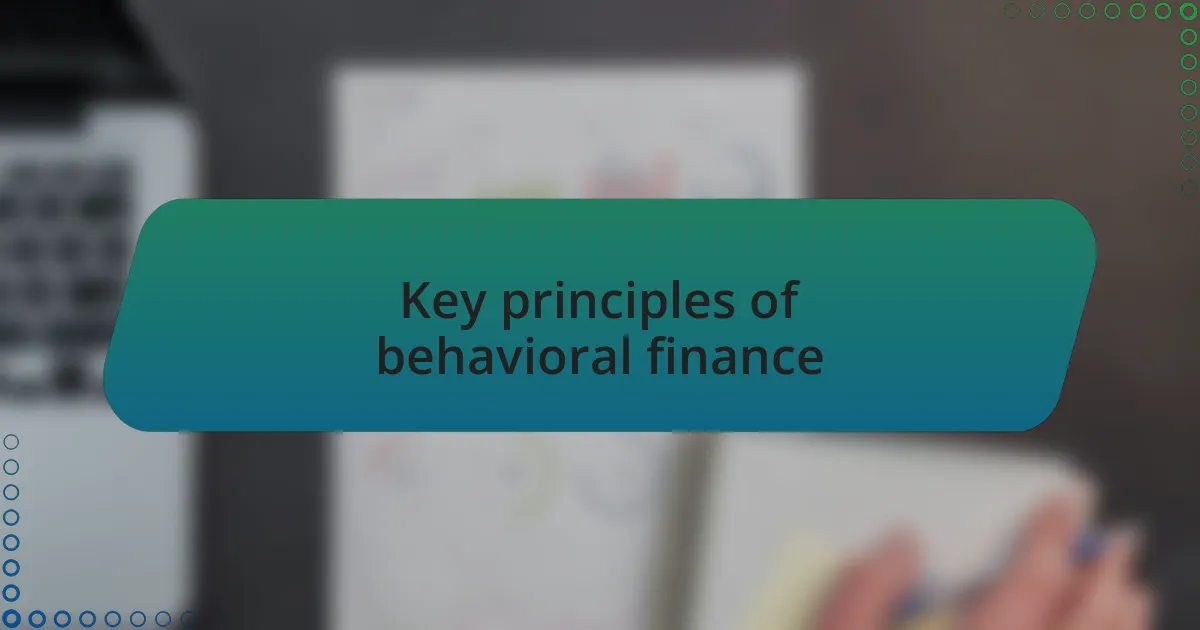Key takeaways:
- Behavioral finance explores how emotions and cognitive biases, like loss aversion and confirmation bias, influence investment decisions.
- Key principles include overconfidence, anchoring, and mental accounting, which can lead to irrational financial behavior.
- Mitigation strategies involve setting predefined investment rules, seeking diverse perspectives, and reflecting on past decisions.
- Personal applications like visualization and mindful decision-making can enhance financial commitment and improve investment strategies.

Understanding behavioral finance insights
Behavioral finance dives deep into how emotions and psychological factors influence our financial decisions. I recall a moment when, during market volatility, I found myself second-guessing my investments based on fear rather than logic. Have you ever felt that overwhelming urge to sell just because everyone else was panicking? That’s the emotional bias at play, often leading us to make irrational choices.
One core tenet of behavioral finance is understanding cognitive biases, those mental shortcuts that impact our judgments. For instance, confirmation bias can lead us to favor information that supports our existing beliefs, while ignoring data that contradicts them. This phenomenon hit home for me when I stubbornly held onto a failing investment, convincing myself it would bounce back, instead of objectively analyzing the market conditions.
Another fascinating insight is the concept of loss aversion, which suggests that the pain of losing is more significant than the pleasure of gaining—something I’ve experienced firsthand. Have you ever dreaded selling an underperforming stock, even when the data clearly indicated it was time to move on? This emotional resistance often clouds our judgment, reinforcing the importance of self-awareness in our financial decision-making.

Key principles of behavioral finance
One of the key principles of behavioral finance is the concept of overconfidence. This was evident to me during a time when I was convinced that my market predictions were infallible. Have you ever been so sure of an investment that you ignored signs suggesting otherwise? This overconfidence often leads investors to take excessive risks, mistakenly believing that prior successes guarantee future profits.
Anchoring is another vital principle, where individuals latch onto specific information when making decisions. I remember analyzing a stock’s price and fixating on its previous high, which clouded my judgment regarding its current value. Have you experienced a similar situation where past prices skewed your perception? This tendency to anchor our decisions to past data can hinder objective investment choices.
Lastly, the principle of mental accounting suggests that we treat money differently based on its origin, leading to inconsistent decision-making. I recall attempting to justify a poor investment decision just because I classified those funds as “play money.” Isn’t it intriguing how our mindset can segment our finances? Recognizing this bias can help us make more rational financial choices, regardless of the source of our funds.

Identifying common investor biases
Understanding common investor biases requires a keen eye on our psychological tendencies. For instance, recency bias often leads us to weigh new information too heavily. I’ve found myself focusing more on the latest market trends while forgetting the power of long-term data. Have you ever made a snap judgment based on recent performance, only to regret it later?
Another prevalent bias is loss aversion, where the fear of losing money outweighs the potential for gains. I once held onto a declining stock for far too long, paralyzed by the thought of realizing a loss. Isn’t it interesting how this emotional response can lead us to make poor choices? Recognizing loss aversion can empower investors to make decisions based on logic rather than fear.
Lastly, herd behavior is a fascinating bias that draws us to follow the crowd, often without examining the fundamentals. I remember the frenzy around a hot tech stock, and against my better judgment, I jumped in because everyone else was doing it. Have you felt that pressure to conform? Acknowledging this bias can help us cultivate a more independent investing approach.

Strategies to mitigate biases
One effective strategy to mitigate biases is setting predefined investment rules. I’ve learned from my own investment journey that creating a checklist of criteria before making decisions helps me stay grounded. Think about it—wouldn’t it be easier to avoid impulsive moves if you had clear guidelines to follow?
Another approach is to seek diverse perspectives. When I consult with colleagues or read varied analyses, it challenges my assumptions. Have you ever noticed how discussing your ideas with others can illuminate blind spots? Engaging with different viewpoints not only helps to counteract my own biases but can also lead to more balanced investment choices.
Lastly, I find reflecting on past decisions particularly valuable. Keeping a journal of my investment choices, along with the reasoning behind them, allows me to review my thought processes. How often do we take the time to analyze our successes and failures? This practice helps me recognize patterns in my biases and refine my approach, turning past experiences into powerful learning opportunities.

Personal application of insights
As I incorporate behavioral finance insights into my investment strategy, one technique I’ve found particularly transformative is visualization. When I visualize my financial goals, I notice an emotional connection that propels my commitment. Have you ever paused to imagine where you want to be in five years? This mental exercise not only reinforces my motivation but also helps me stay focused during market volatility, making the often-stressful investment landscape seem more manageable.
Another practice I’ve embraced is mindful decision-making. Instead of rushing into choices, I take a moment to ask myself why I’m considering a particular investment. This simple pause encourages me to push aside underlying fears or desires and confront the rationale behind my instincts. Have you ever felt that urge to act quickly? Slowing down allows me to differentiate between emotional impulses and strategic moves, which ultimately leads to more informed decisions.
Lastly, I often revisit my risk tolerance. There was a time when market fluctuations would send me into a panic, compelling me to adjust my portfolio impulsively. Working through my comfort levels has given me the clarity to stay the course, even when emotions run high. How do you feel when facing potential losses? Understanding my reaction to risk not only prepares me for downturns but also empowers me to reaffirm my long-term strategy with confidence.

Case studies of successful application
One case study that stands out to me involves a client who struggled with anxiety during market dips. By applying insights from behavioral finance, we introduced a structured communication plan, sharing regular updates that aligned with their investment strategy. Have you ever noticed how information can provide a sense of control? For this client, having those touchpoints transformed their approach, turning overwhelming uncertainty into a manageable routine.
Another success story comes from a situation where a small business owner was hesitant to diversify their investments. They were anchored to a single asset that had historically performed well. After discussing the concept of opportunity cost—what they might lose by not diversifying—they took the leap. Looking back, how often do we hold on to familiar choices out of fear? This shift not only broadened their portfolio but also opened new channels for growth, enabling them to sleep better knowing their future was more secure.
Additionally, I recall working with a retiree who had difficulty adjusting their spending habits after leaving the workforce. We utilized nudges, such as default settings on budget trackers, to help them visualize their cash flow more clearly. Do you think subtle shifts can make a big difference? For them, these tweaks created a newfound awareness that empowered their decision-making, leading to a more sustainable approach to enjoying retirement without constant worry.